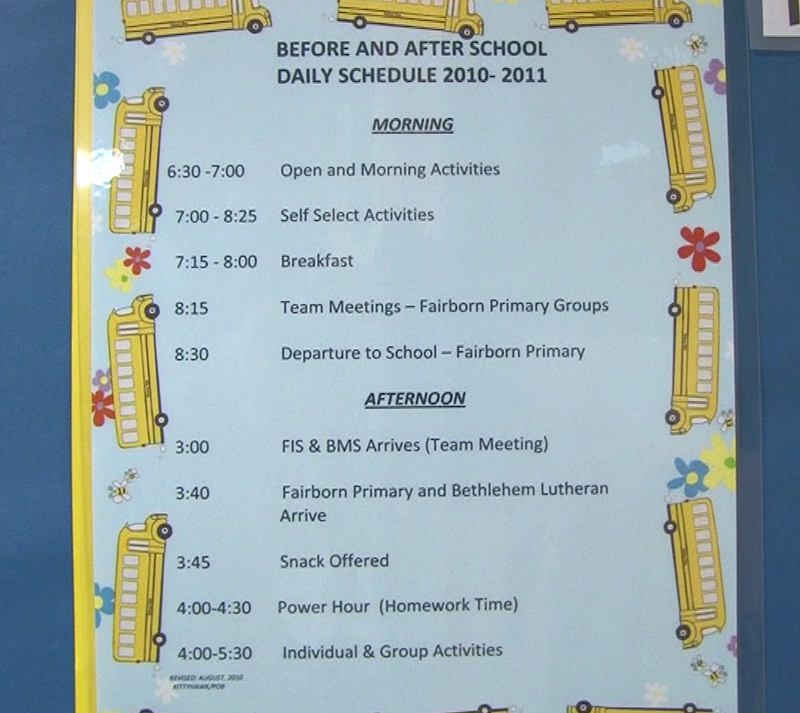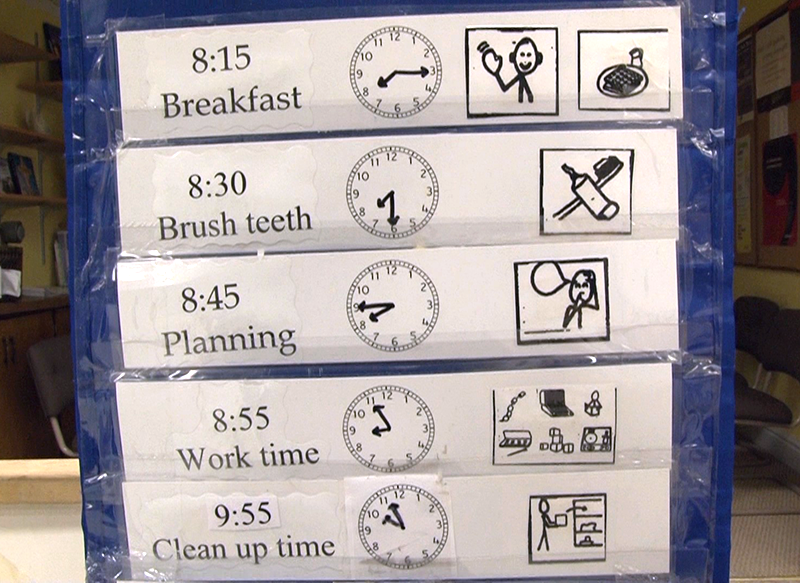- Describe features of the environment that support positive guidance and social development.
- Identify proper methods of supervision to ensure safety and prevent challenging behaviors.
- Recognize methods of including all learners and supporting positive guidance at home and with families.
Learn
Know
Supporting Positive Behavior: The Environment
As you will read in the Learning Environments course, the environment includes not only the physical space and furniture arrangement, but the people, routines, schedules, and character of the space. Young children develop foundational skills for self-regulation in the first five years of life, which means caregivers and early childhood teachers play an important role in helping young children regulate their responses and reactions to experiences. As a school-age staff member, you have the opportunity to continue to explore how the environment can be used as a powerful tool to support the development of self-regulation and to prevent challenging behavior.
Environments for school-age children should incorporate space for distinct activities. This might include computer and tech labs, homework labs, onsite playgrounds, integration of sports and fitness staff, and theme and activity clubs. The activity spaces should be clearly defined with specific boundaries and designed to promote learning and exploration. The focus of individual activity spaces can incorporate academic subjects like math, science, writing, or art. Within certain activity areas or for certain projects, you could also strategically limit materials to help encourage collaboration and teamwork, which fosters the development of social skills. For example, a staff member might provide a limited number of tools in the construction area. This encourages school-age children to take turns and work together. Additionally, school-age children should be instructed on the access, use, and return of materials to ensure that proper engagement and organization of the program areas are maintained.
Routines & Schedules
Children need stability and boundaries in order to feel safe and comfortable in their environments. Managing the time and schedules of the school-age program is an important part of positive guidance. To help reduce behavioral outbursts and anxiety, it is important to maintain a regular schedule. This is especially important for those children in your program that are sensitive or resistant to change. Having a routine, structure, and predictability helps everyone know what is to be expected throughout the program. One of the best ways to achieve this is by posting a daily schedule. Some programs may have an information board where families and children can check the schedule; others may send home a newsletter.
According to the Council on Accreditation’s Standards for Child and Youth Development Programs, the daily schedule should:
- Be flexible
- Provide stability, without being rigid
- Allow children to meet their physical needs in a relaxed way
- Allow children to move smoothly from one activity to another, usually at their own pace
- Facilitate smooth transitions when children need to move together as one group
Posting the daily schedule in a common or central location that all children can access is a great guidance tool for school-age programs. Many programs create visual schedules that include the time, name, and a visual depiction of each activity. This way, children can check throughout the day to see what is coming next. You can also refer to a visual schedule throughout the day to help with transitions. There are many ways to create a visual schedule. Here are some examples:


Flexibility vs. Predictability
It is important that school-age children actively participate in designing their program. This allows them to develop a sense of belonging and ownership, which will help in preventing challenging behaviors. As mentioned in Lesson Two, it is important to first ensure that your program is developmentally appropriate. The schedule needs to be flexible enough to meet individual and group needs while at the same time provide a routine predictable enough for children to know what is expected of them. It is important to recognize that the program schedule should evolve as children’s interests, needs, and experiences develop.
Physical Space
The physical layout of the environment should be designed in a way that supports positive guidance techniques and positive behaviors. The environment should be comfortable for children and allow for clear sight lines for supervision for staff. Your program might have separate rooms for distinct activities (homework, construction, snack, science, etc.), or you might use furniture to designate separate spaces. For example, a set of couches defines the video game or lounge space and a stage defines the dramatic play space.
There are several design principles that support positive behavior. These include:
- Eliminating large open spaces where children feel overwhelmed or where they will run. In all age groups, furniture should be used to help define spaces and encourage safe traffic patterns. Low shelves provide safe boundaries for play and movement. The physical space can be changed or rearranged in a way to accommodate the current interests and needs of the children and activity plans.
- Having comfortable places/soft spaces for children to relax, read or talk with friends. These comfortable quiet places allow children a break from the activity, where they can relax by themselves or catch up with their friends. Sometimes, children need time to reflect or decompress from their busy day at school and giving them the opportunity to do so can help prevent challenging behaviors.
- Providing clearly defined spaces for play, learning, and personal needs. Children should have a safe place for their personal belongings. Providing a bin or cubby to keep their personal items will limit disagreements and worry. Additionally, having a bin or cubby to store children’s personal items encourages responsibility for one’s belongings.
- Providing adequate and accessible materials. Make sure to inventory your program and have the materials you need. There should be sufficient materials to provide children with a variety of choices each day. The materials should be chosen with the interests and backgrounds of the children in mind. All materials must be safe, engaging, and developmentally appropriate. Children should be able to find and access materials, toys, and activities that they are interested in. There should be a system in place that lets children know how and where to find items and put them away.
- Defining the boundaries on the number of children in an area. Some spaces can accommodate larger numbers of children than others. Make sure you consider the needs of children in a space. For example, does an art area become overwhelming when more than four children are there at the same time? Does challenging behavior (arguments) or disengagement (children sitting with no materials or nothing to do) occur when a certain number of children try to play in the art area? Can the school-age science area only accommodate a certain number of children safely? For current high interest areas, are you able to make some areas larger or provide more materials?
For more information about room design, refer to the Learning Environments course.
Supervision
Guidelines should be in place to ensure children’s safety by providing sufficient and appropriate supervision at all times. According to the Council on Accreditation, the supervision system should enable staff to:
- Know where the children and youth are and what they are doing at all times.
- Protect younger children when they move from place to place or use the restroom.
Here are some examples from the Council on Accreditation of how the implementation of this standard is demonstrated:
- There is a system for children and youth to access help at all times.
- Devices such as intercoms, two-way radios, and cordless phones are used to make communication possible between different areas within the program site.
- A system is in place to allow staff members to know which children and youth are in the restroom and how long they have been there.
- Staff members move around an area so they can see or hear all the children and youth they are supervising and position themselves in a way that allows them to watch as many children and youth as possible.
- Convex mirrors are used to supplement line-of-sight supervision.
- Staff members know where children and youth are during transitions (e.g., moving from outdoors to indoors, room to room, and using restrooms for younger children).
- There is a system for monitoring children and youth who have permission to be out of sight, including staff members knowing where they are and checking on them at regular intervals.
- A plan is in place for handling missing or lost children and youth. Check with your program for the specific procedure.
- The level of supervision varies to match the needs of individuals and groups including temperaments and developmental stages.
- The level of supervision respects older youths’ need for independence, including the development of a policy that allows for more independence that is agreed upon by children and youth, their families, and staff members.
It is important to have different levels of supervision in place depending on the activity’s complexity and possible risk factors. Here are some things to keep in mind as you apply this supervision standard from the Council on Accreditation’s Standards for Child and Youth Development Programs:
- Staff members work with small, manageable groups when activities involve dangerous equipment (e.g., using carpentry tools, cooking, leatherworking).
- Staff members closely watch children and youth who are on climbing equipment.
- Staff members watch for hazards including traffic, broken equipment, and trash when children and youth are outdoors.
- A written plan is in place for providing increased supervision for certain activities (e.g., carpentry, cooking, swimming, biking, sledding, ice skating, rollerblading).
- Staff members who supervise potentially risky or harmful activities receive specialized training, as determined by industry safety standards.
- Extra adults are present on field trips that are difficult to supervise (e.g., trips to amusement parks, beaches, ski areas, campgrounds).
- Staff closely supervise any activities that use hot liquids or heat-producing tools.
- There are specific procedures for higher-risk activities (e.g., swimming, gymnastics).
- Ratios of staff members to children and youth are higher and group sizes are smaller when children and youth are learning a new or difficult skill and when projects involve potentially dangerous equipment (e.g., cooking or carpentry).
- Group sizes tend to be larger with sports, art activities, reading, or quiet board games.
- Group sizes may exceed 30 for activities such as outdoor play, performances, or assemblies, as long as adequate supervision is provided.
- Ratios of staff members to children and youth are high enough to ensure that staff members have time to talk with individual children and youth and help them be successful in activities.
- Ratios and group sizes permit staff members to promote positive interactions.
Supervision and Independence in School-Age Children
The standards above are a great place to begin when thinking about the ways supervision helps support guidance in the school-age learning environment. When you think about supervising a preschool-age child versus a middle school child, the picture changes. As school-age children grow, their maturity levels and independence increase. They are working hard to become self-sufficient in many ways; however, they still require constant and active supervision. Active supervision means that you are always alert and observing the children and the environment. When working with a team of staff members, each staff member should be designated to a certain area of the learning environment so that all areas are covered. You should also know how to respond if a conflict, incident or injury occurs in the environment.
There will be times when school-age children are out of sight from staff members. This may happen when children use the restroom or move from one room to another. There should be a system in place for children to access a staff member if needed during these times. For specific information on supervising in your program, see your trainer, coach, or supervisor.
Supporting ALL Learners
Children in your program who have developmental delays or who experience challenging life events or circumstances may also experience challenges with behaviors. These challenges may affect children’s abilities to benefit from high-quality education and to engage in positive social interactions with peers and adults. Even though challenging behaviors are typical for all children, some children show persistent challenging behaviors that may affect their overall school experiences. It is important to provide children with the support they need so they can benefit as much as possible from their school experiences. For these children, you may need to adapt your curriculum, environment, and program experiences to help them be successful. Think about large group activities, transitions, lunch and snack time, indoor and outdoor time, or other program events. What are you doing during these times to ensure you address the needs of all children in your program?
You will also have to work with families to ensure consistency between your program and children’s home. Families may benefit from your program strategies that support children’s positive behaviors. Some children in your care may have conditions that affect their behaviors, including developmental delays, autism, neurological and perceptual disorders, or language and communication delays. Children with Individualized Education Programs (IEPs) have a specific plan to help them meet their educational goals. Very often, these children will need changes or adaptations to the curriculum, program environment, and daily routines.
It is critical that you get to know the children in your program to be able to support their successful participation in your program experiences. Make sure all children and families feel welcome and involved. The Kids Included Together (KIT) program can be a valuable resource for ideas.
Interactions Between Staff and Families
Positive guidance that extends beyond the walls of your program and into the homes of the families you serve helps to strengthen relationships between staff and families. Ongoing communication with families can keep parents and guardians informed of behaviors that occur during the day. Having families’ support can help reinforce skills being taught in your program. The method of communication can be tailored to meet the needs of each family. Some families may prefer daily communication while others may prefer weekly or biweekly communication. Communication methods can include notes, emails, phone calls, newsletters, and individual conferences. Refer to the Communication and Families Courses for more detailed information on communicating with the families of the school-age children in your care.
See
Guidance: The Environment
Do
Creating an Atmosphere of Mutual Respect
The school-age learning environment is more than a physical space; it’s an atmosphere that fosters learning and community for children. Creating a community atmosphere in the learning environment takes time because you must develop relationships with the children in your program. According to the Council on Accreditation, some methods of creating positive relationships with children are:
- Help children feel welcome, comfortable, and supported. Greet each child by name each day.
- Recognize positive accomplishments.
- Treat children with respect.
- Ask questions and share stories to build relationships with the children and youth in your care.
- Listen to what children have to say.
- Respond to children with interest, acceptance, and appreciation.
- Be consistent and follow through on what you say you will do.
If you work to follow these guidelines and to establish relationships with the children in your care, you will see children making positive, safe choices. Children will observe the ways you interact with others and try to model that behavior in their own interactions. As a result, children will experience healthy friendships with one another and enjoy a positive program community. Please refer to the Social & Emotional Development course for more information on creating a community atmosphere in the learning environment.
Additional ways to foster positive relationships with and among the school-age children in your program include:
- Provide materials and experiences that help children think about different emotions and challenging social situations.
- Offer books that discuss common conflicts amongst peers (e.g., being left out of play or not invited to a birthday party) or different everyday situations school-age children may face that could evoke strong emotions.
- Offer writing prompts about one of these challenging experiences and encourage children to share their stories, discussing the emotions they would experience and the solutions they considered to handle the challenge.
- Engage in conversations that offer an opportunity to identify emotions, appropriate strategies for conveying strong emotions, and the opportunity to problem-solve certain social challenges before they occur.
- Model and narrate how you have personal negotiated conflict with a peer. It is important for children to see the entire process.
Explore
Observation is an effective tool for you to learn how the school-age learning environment can support positive behavior. Complete the Observing the Learning Environment activity and share your finished work with your trainer, coach, or administrator.
Apply
Planning activities and experiences that spark the interest and involvement of school-age children will help support positive behavior. Complete the Activity Planning activity and share your finished work with your trainer, coach, or administrator.
Glossary
Demonstrate
Berk, L. E. (2013). Child development (9th ed.). Pearson Education Inc.
Council on Accreditation. Standards for child and youth development (CYD) programs. https://coanet.org/cyd-standards/
Fields, M. V., Merritt, P. P., Fields, D. M., & Perry, N. (2014). Constructive guidance and discipline: Birth to age eight. Pearson Higher Ed. https://www.abebooks.com/9780134547916/Constructive-Guidance-Discipline-Birth-Age-0134547918/plp
Fox, L., Lentini, R., & Binder, D. P. (2013). Promoting the social-emotional competence of all children: Implementing the pyramid model program-wide. Young Exceptional Children Monograph Series No. 15, 1-13.
Gartrell, D. (2012). Education for a civil society: How guidance teaches young children democratic life skills. National Association for the Education of Young Children.
Massachussetts School-Age Coalition (n.d.). School-age child guidance technical assistance paper. MSAC. https://www.mass.gov/files/documents/2016/08/mo/child-guidance-school-age3.pdf
National Association for the Education of Young Children. (2009). Welcome children and families to your classroom. Teaching Young Children, 5(2), 6-7. https://www.naeyc.org/resources/pubs/tyc/apr2013/welcome-children-and-families
Trawick-Smith, J. W. (2014). Early childhood development: A multicultural perspective (6th ed.). Pearson Education Inc.


